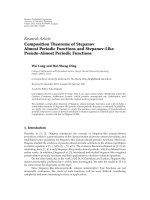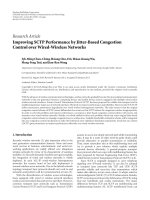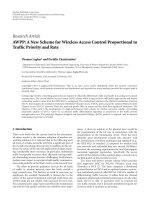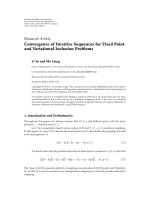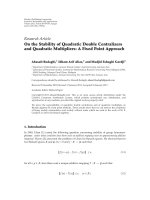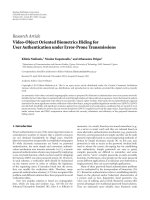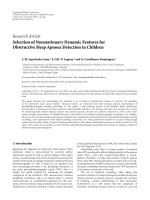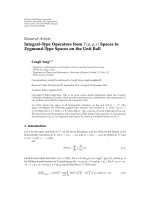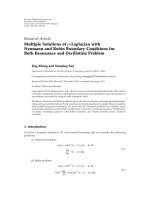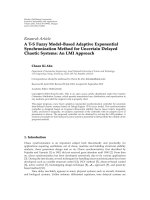Báo cáo hóa học: " Research Article Optimized Punctured ZCZ Sequence-Pair Set: Design, Analysis, and Application to Radar System" doc
Bạn đang xem bản rút gọn của tài liệu. Xem và tải ngay bản đầy đủ của tài liệu tại đây (1.31 MB, 9 trang )
Hindawi Publishing Corporation
EURASIP Journal on Wireless Communications and Networking
Volume 2010, Article ID 254837, 9 pages
doi:10.1155/2010/254837
Research Article
Optimized Punctured ZCZ Sequence-Pair Set: Design, Analysis,
and Application to Radar System
Lei Xu and Qilian Liang (EURASIP Member)
Department of Electrical Engineering, University of Texas at Arlington, Arlington, TX 76010, USA
Correspondence should be addressed to Lei Xu,
Received 23 November 2009; Accepted 26 April 2010
Academic Editor: Xiuzhen (Susan) Cheng
Copyright © 2010 L. Xu and Q. Liang. This is an open access article distributed under the Creative Commons Attribution License,
which permits unrestricted use, distribution, and reproduction in any medium, provided the original work is properly cited.
Based on the zero correlation zone (ZCZ) concept, we present the definitions and properties of a set of new ternary codes, ZCZ
sequence-Pair Set (ZCZPS), and propose a method to use the optimized punctured sequence-pair along with Hadamard matrix
to construct an optimized punctured ZCZ sequence-pair set (OPZCZPS) which has ideal autocorrelation and cross-correlation
properties in the zero correlation zone. Considering the moving target radar system, the correlation properties of the codes will
not be severely affected when Doppler shift is not large. We apply the proposed codes as pulse compression codes to radar system
and the simulation results show that optimized punctured ZCZ sequence-pairs outperform other conventional pulse compression
codes, such as the well-known polyphase code—P4 code.
1. Introduction
Pulse compression is known as a technique to raise the signal
to maximum sidelobe (signal-to-sidelobe) ratio to improve
the target detection and range resolution abilities of the radar
system. This technique allows a radar to simultaneously
achieve the energy of a long pulse and the resolution of a
short pulse without the high peak power which is required by
a high energy short duration pulse [1]. One of the waveform
designs suitable for pulse compression is phase-coded wave-
form design. The phase-coded waveform design is that a long
pulse of duration T is divided into N subpulses each of width
T
s
. Each subpulse has a particular phase, which is selected
in accordance with a given code sequence. The pulse com-
pression ratio equals the number of subpulses N
= T/T
s
≈
BT, where the bandwidth is B ≈ 1/T
s
. In general, a phase-
coded waveform with longer code word, in other words,
higher pulse compression ratio, can have lower sidelobe of
autocorrelation, relative to the mainlobe peak, so its main
peak can be better distinguished. The relative lower sidelobe
of autocorrelation is very important since range sidelobes are
so harmful that they can mask main peaks caused by small
targets situated near large targets. In addition, the cross-
correlation property of the pulse compression codes should
be considered in order to reduce the interference among
radars when we choose a set of pulse compression codes to
work in a Radar Sensor Network (RSN).
Much time and effort was put for designing sequences
with impulsive autocorrelation functions (ACFs) and cross-
correlation functions (CCFs) for radar target ranging and
target detection. On one hand, for aperiodic sequences, it is
known that for most binary sequences of length N (N>13)
the attainable sidelobe levels are approximately
√
N [2, 3]
and the mutual peak cross-correlations of the same-length
sequences are much larger and are usually in the order of
2
√
N to 3
√
N. Later, set of binary sequences of length N with
autocorrelation sidelobes and cross-correlation peak values
of approximately
√
N are studied in paper [4]. Besides, the
small set of Kasami sequences and the Bent sequences could
achieve maximum correlation values of approximately
√
N.
In addition to binary sequences, polyphase codes, with better
Doppler tolerance and lower range sidelobes such as the
Frank and P1 codes, the Butler-matrix derived P2 code, the
linear-frequency-derived P3 and P4 codes were provided and
intensively analyzed in [5–7]. Quadiphase [8] code could also
reduce poor fall-off of the radiated spectrum and mismatch
loss in the receiver pulse compression filter of biphase codes.
Nevertheless, the range sidelobe of the polyphase codes can
not be low enough to avoid masking returns from targets.
Hence, considerable work has been done to reduce range
2 EURASIP Journal on Wireless Communications and Networking
sidelobes for the radar system. By suffering a small S/N loss,
the authors in [9] present several binary pulse compression
codes to greatly reduce sidelobes. In the previous paper [10],
pulse compression using a digital-analog hybrid technique
is studied to achieve very low range sidelobes for potential
application to spaceborne rain radar. In the paper [11], time-
domain weighting of the transmitted pulse is used and is able
toachievearangesidelobelevelof
−55 dB or better in flight
tests. These sidelobe suppression methods, however, degrade
the receiving resolution because of wider mainlobe.
On the other hand, for periodic sequences, the lowest
periodic ACF that could be achieved for binary sequences, as
in the case of m-sequences [12, 13] or Legendre sequences,
is
|R
i
(τ
/
=0) = 1|.GMW[14] has the same periodic
ACF properties, but posses larger linear complexity. Con-
sidering the nonbinary case, it is possible to find perfect
sequences, such as two valued Golomb sequences, Ipatov
ternary sequences, Frank sequences, Chu sequences, and
modulatable sequences. However, it should be noted that
for both binary and non-binary cases, it is impossible for
the sequences to have perfect ACF and CCF simultaneously
although ideal CCFs could be achieved alone. One can
synthesize a set of non-binary sequences with impulsive ACF
and the lower bound of CCF: R
ij
=
√
N, ∀τ, i
/
= j [15, 16],
which is governed by Welch bound and Sidelnikov bound.
So far in the previous work, range sidelobes could hardly
reach as low as zero. In addition, it has also been well proven
that it is impossible to design a set of codes with ideal impul-
sive autocorrelation function and ideal zero cross-correlation
functions, since the corresponding parameters have to be
limited by certain bounds, such as Welch bound [15],
Sidelnikov bound [16], Sarwate bound [17], and Levenshtein
bound [18]. To overcome these difficulties, the new concepts,
generalized orthogonality (GO), also called Zero Correlation
Zone (ZCZ) is introduced. Based on ZCZ [19–21]concept,
we propose a set of ternary codes, ZCZ sequence-pair set,
which can reach zero autocorrelation sidelobe zero mutual
cross-correlation peaks during Zero Correlation Zone. We
also present and analyze a method to construct such ternary
codes and subsequently apply them to a radar detection
system. The method is that optimized punctured sequence-
pair joins together with Hadamard matrix to construct
optimized punctured ZCZ sequence-pairs set. An example
is presented, investigated, and studied in the radar targets
detection simulation system for the performance evaluation
of the proposed ternary codes. Because of the outstanding
property performance and well target detection performance
in simulation system, the newly proposed codes can be
useful candidates for pulse compression application in radar
system.
The rest of the paper is organized as follows. Section 2
introduces the definitions and properties of ZCZPS. In
Section 3, the optimized punctured ZCZPS is introduced,
and a method using optimized punctured sequence-pair
and Hadamard matrix to construct such codes is given
and proved. In Section 4, the properties and ambiguity
function of optimized punctured ZCZPS are simulated and
analyzed. The performance of optimized punctured ZCZPS
is investigated in radar targets detection system by comparing
with P4 code in Section 5.InSection 6, conclusions are
drawn on optimized punctured ZCZPS.
2. Definitions and Properties of
ZCZ Sequence-Pair Set
Zero Correlation Zone (ZCZ) is a new concept provided by
Fan et al. [21, 22] in which the autocorrelation sidelobes and
cross-correlation values are zero while the time delay is kept
within ZCZ instead of the whole period of time domain.
There has been considerable interest in constructing [23–
27] new classes of ZCZ sequences in ZCZ and studying their
properties [28].
Here, we introduce sequence-pair into the ZCZ concept
to construct ZCZ sequence-pair set. We consider ZCZPS
(X, Y), X is a set of K sequences of length N and Y is a set
of K sequences of the same length N:
x
(p)
∈ X p = 0, 1, 2, , K − 1,
y
(q)
∈ Y q = 0, 1, 2, , K − 1.
(1)
The autocorrelation function (ACF) (here we use auto-
correlation to stand for the cross-correlation between two
different sequences of a sequence-pair to distinguish the
cross-correlation between two different sequence-pairs) of
sequence-pair (x
(p)
, y
(p)
)isdefinedby
R
x
(p)
y
(p)
(
τ
)
=
N−1
i=0
x
(p)
i
y
(p)∗
(i+m)modN
,0≤ m ≤ N − 1
. (2)
The cross-correlation function of two sequence-pairs
(x
(p)
, y
(p)
)and(x
(q)
, y
(q)
), p
/
=q is defined by
C
x
(p)
y
(q)
(
τ
)
=
N−1
i=0
x
(p)
i
y
(q)∗
(
i+m
)
mod N
,0≤ m ≤ N − 1,
(3)
where τ
= mT
s
is the time delay and T
s
is the bit duration.
For pulse compression sequences, some properties are
of particular concern in the optimization for any design
in engineering field. They are the peak sidelobe level,
the energy of autocorrelation sidelobes, and the energy
of their mutual cross-correlation [4]. Therefore, the peak
sidelobe level which represents a source of mutual inter-
ference and obscures weaker targets can be presented as
max
K
|R
x
(p)
y
(p)
(τ)|=0, τ is among the zero correlation
zone for ZCZPS. Another optimization criterion for the set
of sequence-pairs is the energy of autocorrelation sidelobes
joined together with the energy of cross-correlation. By
minimizing the energy, it can be distributed evenly, and the
peak autocorrelation sidelobe and the cross-correlation level
can be minimized as well [4]. Here, the energy of ZCZPS can
be employed as
E
=
K−1
p=0
Z
0
τ=1
R
2
x
(p)
y
(p)
(
τ
)
+
K−1
p=0
K
−1
q=0,q
/
= p
Z
0
τ=0
C
x
(p)
y
(q)
(
τ
)
.
(4)
According to (4), it is obvious to see that the energy can be
kept low while minimizing the autocorrelation sidelobes and
EURASIP Journal on Wireless Communications and Networking 3
cross-correlation values of any two sequence-pairs within
Zero Correlation Zone.
Hence, the ZCZPS can be constructed by minimizing
the autocorrelation sidelobe of a sequence-pair and cross-
correlation value of any two sequence-pairs in ZCZPS.
Definition 1. Assume (X, Y) to be a sequence-pair set of K
sequence-pairs and each sequence-pair is of N bit length.
If all the sequence-pairs in the set satisfy the following
equation:
R
x
(p)
y
(q)
(
τ
)
=
N−1
i=0
x
(p)
i
y
(q)∗
(i+m)mod(N)
=
N−1
i=0
y
(p)
i
x
(q)∗
(i+m)mod(N)
=
⎧
⎪
⎪
⎪
⎪
⎨
⎪
⎪
⎪
⎪
⎩
λN,form = 0, p = q,
0, for m
= 0, p
/
=q,
0, for 0 <
|m|≤Z
0
,
(5)
where p, q
= 1, 2, 3, , K −1, i = 0, 1, 2, , N −1, 0 <λ≤ 1
and τ
= mT
s
.Then(x
(p)
, y
(p)
)iscalledaZCZsequence-
pair, ZCZP is an abbreviation, and (X, Y) is called a ZCZ
sequence-pair set, ZCZPS(N, K, Z
0
) is an abbreviation.
3. Optimized Punctured ZCZ Sequence-Pair Set
3.1. Definition of Optimized Punctured ZCZ Sequence-Pair
Set. Matsufuji and Torii have provided some methods of
constructing ZCZ sequences in [29, 30]. In this section, a
set of novel ternary codes, namely, the optimized punctured
ZCZ sequence-pair set, is constructed by applying the opti-
mized punctured sequence-pair [31] to the Zero Correlation
Zone. Here, optimized punctured ZCZPS is a specific kind of
ZCZPS.
Definition 2 (see [31]). Sequence u
= (u
0
, u
1
, , u
N−1
) is the
punctured sequence for v
= (v
0
, v
1
, , v
N−1
)
u
j
=
⎧
⎨
⎩
0, if u
j
is punctured,
v
j
,ifu
j
is non-punctured,
(6)
where P is the number of punctured bits in sequence
u.Supposev
j
∈ (−1, 1) and u
j
∈ (−1, 0,1), u is P-
punctured binary sequence, (u, v) is called a punctured
binary sequence-pair.
Definition 3 (see [31]). The autocorrelation of punctured
sequence-pair (u, v)isdefinedas
R
uv
(
τ
)
= R
uv
(
mT
s
)
=
N−1
i=0
u
i
v
(i+m)modN
,0≤ m ≤ N − 1.
(7)
If the punctured sequence-pair has the following auto-
correlation property:
R
uv
(
mT
s
)
=
⎧
⎨
⎩
E,ifm ≡ 0modN,
0, otherwise,
(8)
the punctured sequence-pair is called an optimized punc-
tured sequence-pair [31]. Where, E
=
N−1
i=0
u
i
v
i
= N − P,
is the energy of punctured sequence-pair.
Definition 4. If (X, Y)inDefinition 1 is constructed by
optimized punctured sequence-pair and a certain matrix,
such as Hadamard matrix or an orthogonal matrix, where
x
(p)
i
∈
(
−1, 1
)
, i = 0, 1, 2, , N − 1,
y
(q)
i
∈
(
−1, 0, 1
)
, i = 0, 1, 2, , N − 1.
(9)
Then
R
x
(p)
y
(q)
(
τ
)
=
N−1
i=0
x
(p)
i
y
(q)∗
(
i+m
)
mod N
=
⎧
⎪
⎪
⎪
⎪
⎨
⎪
⎪
⎪
⎪
⎩
λN,form=0, p = q,
0, for m
=0, p
/
=q,
0, for 0 <
|m|≤Z
0
,
(10)
where 0 <λ
≤ 1andτ = mT
s
, then (X, Y)can
be called an optimized punctured ZCZ sequence-pair set.
OPZCZPS(N, K, Z
0
) is an abbreviation.
3.2. Design of Optimized Punctured ZCZ Sequence-Pair Set.
Based on an optimized punctured binary sequence-pair of
odd length and a Hadamard matrix, an optimized punctured
ZCZPS can be constructed on following steps.
Step 1. Considering an optimized punctured binary
sequence-pair (u, v) of odd length, the length of each
sequence is N
1
:
u
= u
0
, u
1
, , u
N
1
−1
, u
i
∈
(
−1, 1
)
,
v
= v
0
, v
1
, , v
N
1
−1
, v
i
∈
(
−1, 0, 1
)
,
i
= 0, 1, 2, , N
1
− 1, N
1
is odd.
(11)
Step 2. A Hadamard matrix B (the Hadamard matrix is made
up of a set of Walsh sequences) of order N
2
is used here. N
2
,
the length of each sequence, is equal to the number of the
sequences in the matrix. Here, any Hadamard matrix order
is possible and b
(p)
is the row vector of the matrix:
B
=
b
(0)
; b
(1)
; ; b
(N
2
−1)
,
b
(p)
=
b
(p)
0
, b
(p)
1
, , b
(p)
N
2
−1
,
R
b
(p)
b
(q)
=
⎧
⎨
⎩
N
2
,ifp = q,
0, if p
/
=q.
(12)
4 EURASIP Journal on Wireless Communications and Networking
Step 3. Doing bit-multiplication on the optimized punc-
tured binary sequence-pair and each row of the Hadamard
matrix B, then sequence-pair set (X, Y) is obtained,
b
(p)
=
b
(p)
0
, b
(p)
1
, , b
(p)
N
2
−1
, p = 0, 1, ,N
2
− 1,
x
(p)
j
= u
j mod N
1
b
(p)
j mod N
2
,0≤ p ≤ N
2
− 1, 0 ≤ j ≤ N − 1,
X
=
x
(0)
; x
(1)
; ; x
(N
2
−1)
,
y
(p)
j
= v
j mod N
1
b
(p)
j mod N
2
,0≤ p ≤ N
2
− 1, 0 ≤ j ≤ N − 1,
Y
=
y
(0)
; y
(1)
; ; y
(N
2
−1)
.
(13)
Here, the optimized punctured binary sequence-pairs
are of odd lengths and the lengths of Walsh sequence are
2
n
, n = 1, 2, It is easy to see that gcd(N
1
, N
2
) = 1,
common divisor of N
1
and N
2
is 1, then N = N
1
∗ N
2
.
The sequence-pair set (X, Y) is the optimized punctured
ZCZPS and N
1
− 1 is the Zero Correlation Zone Z
0
.The
length of each sequence in optimized punctured ZCZPS is
N
= N
1
∗ N
2
that depends on the product of length of
optimized punctured sequence-pair and the length of Walsh
sequence in Hadamard matrix. The number of sequence-
pairs in optimized punctured ZCZPS rests on the order of
the Hadamard matrix. The sequence x
(p)
in sequence set
X and the corresponding sequence y
(p)
in sequence set Y
construct a sequence-pair (x
(p)
, y
(p)
) that can be used as a
pulse compression code.
The correlation property of the sequence-pairs in opti-
mized punctured ZCZPS is
R
x
(p)
y
(q)
(
τ
)
= R
uv
(
m mod N
1
)
R
b
(p)
b
(q)
(
m mod N
2
)
=
⎧
⎪
⎪
⎪
⎪
⎨
⎪
⎪
⎪
⎪
⎩
EN
2
,ifm = 0, p = q,
0, if 0 <
|m|≤N
1
− 1, p = q,
0, if 0
≤|m|≤N
1
− 1, p
/
=q,
(14)
where N
1
− 1 is the Zero Correlation Zone Z
0
and τ = mT
s
.
Proof. (1) When p
= q,
τ
= 0, R
uv
(
0
)
= E, R
b
(p)
b
(q)
(
0
)
= N
2
,
R
x
(p)
y
(q)
(
0
)
= R
uv
(
0
)
R
b
(p)
b
(q)
(
0
)
= EN
2
,
0 <
|τ|≤
(
N
1
− 1
)
T
s
, R
uv
(
τ
)
= 0,
R
x
(p)
y
(q)
(
τ
)
= R
uv
(
m mod N
1
)
R
b
(p)
b
(q)
(
m mod N
2
)
= 0.
(15)
(2) When p
/
=q,
τ
= 0, R
b
(p)
b
(q)
(
0
)
= 0,
R
x
(p)
y
(q)
(
0
)
= R
uv
(
0
)
R
b
(p)
b
(q)
(
0
)
= 0,
0 <
|τ|≤
(
N
1
− 1
)
T
s
,
R
uv
(
τ
)
= 0,
R
x
(p)
y
(q)
(
τ
)
= R
uv
(
m mod N
1
)
R
b
(p)
b
(q)
(
m mod N
2
)
= 0.
(16)
According to Definition 1, the OPZCZPS constructed by
the above method is a ZCZPS.
4. Properties of Optimized Punctured ZCZ
Sequence-Pair Set
Considering the optimized punctured ZCZPS constructed
by the method mentioned in the last section, the autocor-
relation and cross-correlation properties can be simulated
and analyzed. For example, the optimized punctured ZCZPS
(X, Y) is constructed by 31-length optimized punctured
binary sequence-pair (u, v), u
= [++++−−−+−+ −+++
−−−−+−−+−−+++−++−], v = [++++000+0+0+
+ + 0000 + 00 +00+++0++0](using“+”and“
−”symbols
for “1” and “
−1”) and Hadamard matrix H of order 4. We
follow the three steps presented in Section 3.2 to construct
the optimized punctured ZCZPS. The number of sequence-
pairs here is 4, and the length of each sequence is 31
∗ 4 =
124. The first row of each matrix X = [x
(1)
; x
(2)
; x
(3)
; x
(4)
]
and Y
= [y
(1)
; y
(2)
; y
(3)
; y
(4)
] constitute a certain optimized
punctured ZCZP (x
(1)
, y
(1)
). Similarly, the second row of each
matrix X and Y constitute another optimized punctured ZCZ
sequence-pair (x
(2)
, y
(2)
), and so on:
x
(1)
=
[
++++
−−−+ −+ −+++−−−−+ −−+ −−
+++− ++−++++−−−+ −+ −+++−−
−−
+ −−+ −−+++− ++−++++−−−+
− + −+++−−−−+ −−+ −−+++−++−
++++−−−+ −+ −+++−−−−+ −−+−
−
+++− ++−
]
,
y
(1)
=
[
++++000+0+0+++0000 + 00 + 00 + + + 0
+ +0 + + + +000 + 0 + 0 + + + 0000 + 00 + 00 + +
+0++0++++000+0+0+++0000 + 00 + 00
+ + + 0 + +0 + + + +000 + 0 + 0 + + + 0000 + 00
+00+++0++0
]
,
x
(2)
=
[
+
− + −−+ −−−−−−+ −−+ −+++−−−
++− +++−−−+ − ++−++++++− ++−
+ −−−+++−−+ −−−+++− + −−+ −−
−−−−
+ −−+ − +++−−−++−+++−
−−
+ −++−++++++−++− + −−−+
++
−−+ −−−++
]
,
EURASIP Journal on Wireless Communications and Networking 5
y
(2)
=
[
+
− + −000 −0 −0 −+ −0000 + 00 −00 + − +0
+
−0 −+ −+000+0+0+− + 0000 −00 + 00
− + − 0 −+0 + −+ −000 −0 −0 −+ − 0000
+00
− 00 + −+0+−0 − + − +000+0+0+−
+0000 −00 + 00 −+ − 0 − +0
]
. (17)
Here, optimized punctured ZCZ sequence-pairs (x
(1)
, y
(1)
)
and (x
(2)
, y
(2)
) are studied as two examples in the following
parts.
4.1. Autocorrelation and Cross-Correlation Properties. The
autocorrelation property and cross-correlation property of
124-length sequence-pairs in the optimized punctured ZCZ
sequence-pair set (X, Y) are shown in Figures 1 and 2.
From the Figures 1 and 2, the peak autocorrelation
sidelobe of ZCZPS and their cross-correlation value are kept
as low as zero while the time delay is kept within Z
0
= N
1
−
1 = 30 (Zero Correlation Zone). And it is always true that
the cross-correlation values of optimized punctured ZCZPS
and the autocorrelation sidelobe could be kept as low as zero
during ZCZ.
We still have to confess that the energy loss of the
proposed codes is no less than 1.7 db due to reference
mismatch. However, the perfect periodic ACF and CCF
achieved simultaneously during the ZCZ zone and the
codes’ structure could make up for it. It is known that a
suitable criterion for evaluating code of length N is the
ratio of the peak signal mainlobe divided by the peak signal
sidelobe (PSR) of their autocorrelation function, which can
be bounded by [32]
[
PSR
]
dB
≤ 20 log
2
N =
[
PSR
max
]
dB
.
(18)
The only aperiodic uniform phase codes that can reach the
PSR
max
are the Barker codes whose length is equal or less than
13. Considering the periodic sequences, the m-sequences or
Legendre sequences could achieve the lowest periodic ACF
of
|R
i
(τ
/
=0) = 1|. For non-binary sequences, it is possible
to find perfect sequences of ideal ACF. Golomb codes are
a kind of two valued (biphase) perfect codes which obtain
zero periodic ACF but result in large mismatch power loss.
The Ipatov code shows a way of designing code pairs with
perfect periodic autocorrelation (the cross-correlation of the
code pair) and minimal mismatch loss. In addition, zero
periodic autocorrelation function for all nonzero shifts could
be obtained by polyphase codes, such as Frank and Zadoff
codes. However, for both binary and non-binary periodic
sequences, it is not possible for the sequences to have perfect
ACF and CCF simultaneously although ideal CCFs could
be achieved alone. Comparing with the above codes, the
proposed ternary codes could obtain perfect periodic ACF
during the ZCZ and the reference sequence is made of
(
−1,0,1)whichismuchlesscomplicatedthanotherperfect
ternary codes such as Ipatvo code. The reference code for
Ipatov code is of a three-element alphabet which might not
always be integer.
−150 −100 −50 0 50 100 150
0
0.1
0.2
0.3
0.4
0.5
0.6
0.7
0.8
0.9
1
Delay τ/T
s
Normalized amibiguity cut for F
d
= 0
Figure 1: Periodic autocorrelation property of optimized punc-
tured ZCZPS.
Nevertheless, considering multi targets in the system,
multiple peaks of the autocorrelation function of the pro-
posed codes might affect on the range resolution. The range
resolution could be limited as T
s
<τ<N
1
T
s
or τ>NT
s
.
Here, T
s
is one bit duration, N
1
is the length of an optimized
punctured sequence-pair and N is the length of an optimized
punctured ZCZ sequence-pair. In the Figure 1, N
1
= 31.
Otherwise, some digital signal processing methods could
also be introduced to distinguish the peaks. On the other
hand, there may also be the concern that multiple peaks of
single transmitting signal reflected from one target may affect
determining the main peak of ACF. As a matter of fact, the
matched filter here could shift at the period of ZCZ length
to track each peak instead of shifting bit by bit after the first
peak is acquired. Hence, in this way could it be working more
efficiently. Alike the tracking technology in synchronization
of CDMA system, checking several peaks instead of only one
peak guarantee the precision of P
D
and avoidance of P
FA
.
In addition, those obtained peaks could be averaged before
the detection in order to reduce the effect of random noise
in the channel so that the detection performance could be
improved.
To sum up, the new code could achieve perfect ACF and
CCF in the ZCZ simultaneously according to Figures 1 and
2, and its PSR can be as large as infinite.
4.2. Ambiguity Function. When the transmitted impulse
is reflected by a moving target, the reflected echo signal
includes a linear phase shift which corresponds to a Doppler
shift F
d
[32]. As a result of the Doppler shift F
d
, the main
peak of the autocorrelation function is reduced. The SNR is
degraded and the sidelobe structure is also changed because
of the Doppler shift.
6 EURASIP Journal on Wireless Communications and Networking
−150 −100 −50 0 50 100
150
−1
−0.8
−0.6
−0.4
−0.2
0
0.2
0.4
0.6
0.8
1
Delay τ/T
s
Normalized amibiguity cut for F
d
= 0
Figure 2: Periodic cross-correlation property of optimized punc-
tured ZCZPS.
The ambiguity function which is usually used to analyze
the radar performance within Doppler shift and time delay is
defined in [32]:
A
(
τ, F
D
)
≡
∞
−∞
x
(
s
)
e
j2πF
D
s
x
∗
(
s
− τ
)
ds
≡
A
(
τ, F
D
)
,
(19)
where τ is the time delay between transmitting signal and
matched filter, and F
D
is the Doppler shift.
In [33], Periodic Ambiguity Function (PAF) is intro-
duced by Levanon as an extension of the periodic autocor-
relation for Doppler shift. And the single-periodic complex
envelope is [34]
A
periodic
(
τ, F
D
)
≡
1
T
T
0
x
s +
τ
2
e
j2πF
D
s
x
∗
s −
τ
2
ds
≡
A
periodic
(
τ, F
D
)
,
(20)
where T is one period of the signal.
We are studying sequence-pairs in this research, so we
use different codes for transmitting part and receiving part.
The single-period ambiguity function for ZCZPS can be
rewritten as
A
pair
(
τ, F
D
)
≡
A
pair
(
τ, F
D
)
=
1
T
T
0
x
(p)
s +
τ
2
e
j2πF
D
s
y
(q)∗
s −
τ
2
ds
,
(21)
where p, q
= 0, 1, 2, ,K − 1, T = NT
s
is one period
of the signal and T
s
is one bit duration. At the same time,
when p
= q,(21) can be used to analyze the autocorrelation
property within Doppler shift, and when q
/
= p,(21)can
be used to analyze the cross-correlation performance within
Doppler shift. Equation (21) is plotted in Figure 3 in a three-
dimensional surface plot to analyze the radar performance
of optimized punctured ZCZPS within Doppler shift. Here,
maximal time delay is 1 unit (normalized to length of the
code, in units of NT
s
) and maximal Doppler shift is 5
units for cross-correlation and 3 units for autocorrelation
(normalized to the inverse of the length of the code, in units
of 1/NT
s
).
In Figure 3(a), there is relative uniform plateau sug-
gesting low and uniform sidelobes. This low and uniform
sidelobes minimize target masking effectinZeroCorrelation
Zone of time domain, where Z
0
= 30, −30τ
c
≤ τ ≤ 30τ
c
.
From Figure 3(b), considering cross-correlation property
between any two optimized punctured ZCZ sequence-pairs
of the ZCZPS, we can see that the optimized punctured
ZCZPS is tolerant of Doppler shift when Doppler shift is
not large. When the Doppler shift is zero, or the target is
not moving, cross-correlation of our proposed code is zero
during ZCZ.
Since synchronizing techniques develop exponentially in
the industrial world, time delay between transmitting signal
and matched filter can, to some extent, be precisely esti-
mated. Therefore, it is necessary to investigate the property of
our proposed code when we have the output of the matched
filter at the expected time τ
= 0. When τ = 0, the ambiguity
function can be expressed as
A
pair
(
0, F
D
)
=
1
T
T
0
x
(p)
(
s
)
y
(q)∗
(
s
)
e
(j2πF
D
s)
ds
. (22)
And the Doppler shift performance without time delay is
presented in the Figure 4.
Figure 4(a) illustrates that without time delay of matched
filter but having the Doppler shift less than 1 unit, the
autocorrelation value of optimized punctured ZCZPS falls
sharply during one unit, and the trend of the amplitude over
the whole frequency domain decreases as well. Figure 4(b)
shows that there are some convex surfaces in the cross-
correlation performance. From Figures 4(a) and 4(b), when
Doppler frequencies equal to multiples of the pulse repetition
frequency (PRF
= 1/PRI = 1/Ts), all the ambiguity values
turn to zero except when Doppler frequency is equal to 2
PRF for cross-correlation. That is the same as many widely
used pulse compression binary code such as the Barker code.
Overall, the ambiguity function performances of optimized
punctured ZCZP can be as efficient as conventional pulse
compression binary code.
5. Application to Radar System
According to [32], Probability of Detection (P
D
), Probability
of False Alarm (P
FA
) and Probability of Miss (P
M
) are three
probabilities of most interest in the radar system. Note
that P
M
= 1 − P
D
. Therefore, we simulated the above
three probabilities of using 124-length optimized punctured
ZCZ sequence-pair in radar system in this section. The
performance of radar system using 124-length P4 code is
also studied in order to compare with the performance of
optimized punctured ZCZ sequence-pairs of corresponding
EURASIP Journal on Wireless Communications and Networking 7
0
0.5
1
1.5
2
2.5
3
−100
−50
0
50
100
Doppler shift F
d
∗
NT
s
Delay τ/T
s
|χ(τ, F
d
)|
0
0.2
0.4
0.6
0.8
1
(a)
0
1
2
3
4
5
−100
−50
0
50
100
Doppler shift F
d
∗
NT
s
Delay τ/T
s
|χ(τ, F
d
)|
0
0.2
0.4
0.6
0.8
1
(b)
Figure 3: Ambiguity function of 124-length ZCZPS: (a) autocorre-
lation, (b) cross-correlation.
length. In the simulation model, 10
5
times of Monte-Carlo
simulation has been run for each SNR value. The Doppler
shift frequency is a random variable that is kept less than 1
unit (normalized to the inverse of the length of the code, in
units of 1/NT
s
), and the expected peak time of the output of
the matched filter is at τ
= 0.
From Figure 5, the probabilities of miss target detection
P
M
of the system using 124-length optimized punctured
ZCZP are lower than 124-length P4 code especially when
the SNR is not high. When SNR is higher than 18 dB, both
probabilities of miss targets of the system approach zero.
However, the probabilities of miss targets of P4 code fall more
quickly than optimized punctured ZCZP.
We plotted the detection probability P
D
versus false
alarm probability P
FA
of the coherent receiver. We have
simulated the performance at different SNR values. Because
of the limited space, we only chose SNR at 12 db and
14 dB. Figure 6 shows performance of 124-length optimized
punctured ZCZP and performance of the same length P4
code when the SNR is 12 dB and 14 dB. Within the same
SNR value either 12 dB or 14 dB, the detection probabilities
of optimized punctured ZCZ sequence-pair are much larger
0 0.5 1 1.5 2 2.5 3
0
0.1
0.2
0.3
0.4
0.5
0.6
0.7
0.8
0.9
1
Nor malised amibiguity cut for τ = 0
Doppler shift F
d
∗
NT
s
(a)
00.511.522.533.544.55
0
0.1
0.2
0.3
0.4
0.5
0.6
0.7
Nor malised amibiguity cut for τ = 0
Doppler shift F
d
∗
NT
s
(b)
Figure 4: Doppler shift of 124-length ZCZPS (τ = 0): (a)
autocorrelation (b) cross-correlation.
than detection probabilities of P4 code, and meanwhile P
FA
of the first code are also smaller than P
FA
of the latter code.
Stating differently, optimized punctured ZCZ sequence-pair
has higher target detection probability while keeping a lower
false alarm probability. Furthermore, observing Figure 6,
124-length optimized punctured ZCZ sequence-pair even
has much better performance at 12 dB SNR than P4 code of
corresponding length at 14 dB SNR.
6. Conclusions
The definition and properties of a set of newly provided
ternary codes-ZCZ sequence-pair set were discussed in
this paper. Based on optimized punctured sequence-pair
and Hadamard matrix, we have investigated a constructing
method for a specific ZCZPS-optimized punctured ZCZPS
made up of a set of optimized punctured ZCZPs along
with studying its properties. The significant advantage of the
8 EURASIP Journal on Wireless Communications and Networking
12 13 14 15 16 17 18 19 20
0
0.02
0.04
0.06
0.08
0.1
0.12
0.14
0.16
Punctured
P4
SNR (dB)
Probability of miss, P
m
Figure 5: Probability of miss targets detection: 124-length opti-
mized punctured ZCZ sequence-pair versus 124-length P4 code.
−2.6 −2.4 −2.2 −2 −1.8 −1.6 −1.4 −1.2 −1 −0.8
0.7
0.75
0.8
0.85
0.9
0.95
1
14 dB-P4
12 dB-P4
Probability of detecion, P
d
14 dB-punctured
12 dB-punctured
Probability of false alarm (base 10 logarithm of P
fa
)
Figure 6: Probability of detection versus probability of false alarm
of the coherent receiver: 124-length optimized punctured ZCZ
sequence-pair versus 124-length P4 code.
optimized punctured ZCZPS is the considerably reducedn
autocorrelation sidelobe and zero mutual cross-correlation
value during ZCZ. According to the radar system simulation
results shown in Figures 5 and 6, it is easy to observe that 124-
length optimized punctured ZCZPS has better performance
than P4 code of the same length when the target is not
moving very fast in the system. A general conclusion can
be drawn that the optimized punctured ZCZPS consisting
of optimized punctured ZCZ sequence-pairs can effectively
increase the variety of candidates for pulse compression
codes. Because of the ideal cross-correlation properties of
optimized punctured ZCZPS, our future work would focus
on the application of the optimized punctured ZCZPS in
multiple radar systems.
Acknowledgment
This work was supported in part by the National Science
Foundation under Grants CNS-0721515, CNS- 0831902,
CCF-0956438, CNS-0964713, and Office of Naval Research
(ONR) under Grant N00014-07-1-0395 and N00014-07-1-
1024.
References
[1] S. Ariyavisitakul, N. Sollenberger, and L. Greenstein, Introduc-
tion to Radar System, Tata McGraw-Hill, Delhi, India, 2001.
[2] A. M. Boehmer, “Binary pulse compression codes,” IEEE
Transactions on Information Theory, vol. 13, pp. 156–167,
1967.
[3] R. Turyn, “On Barker codes of even length,” Proceedings of the
IEEE, vol. 51, no. 9, p. 1256, 1963.
[4] U. Somaini, “Bianry sequences with good autocorrelation and
cross correlation properties,” IEEE Transactions on Aerospace
and Electronic Systems, vol. 11, no. 6, pp. 1226–1231, 1975.
[5] R. L. Frank, “Polyphase codes with good nonperiodic correla-
tion properties,” IEEE Transactions on Information Theory, vol.
9, pp. 43–45, 1963.
[6] B.L.LewisandF.F.KretschmerJr.,“Anewclassofpolyphase
pulse compression codes and techniques,” IEEE Transactions
on Aerospace and Electronic Systems, vol. 17, no. 3, pp. 364–
372, 1981.
[7] B. L. Lewis and F. F. Kretschmer Jr., “Linear frequency
modulation derived polyphase pulse compression codes,”
IEEE Transactions on Aerospace and Electronic Syste ms, vol. 18,
no. 5, pp. 637–641, 1982.
[8] J. W. Taylor Jr. and H. J. Blinchikoff, “Quadriphase code—a
radar pulse compression signal with unique characteristics,”
IEEE Transactions on Aerospace and Electronic Syste ms, vol. 24,
no. 2, pp. 156–170, 1988.
[9] R. Sato and M. Shinrhu, “Simple mismatched filter for
binary pulse compression code with small PSL and small S/N
loss [radar],” IEEE Transactions on Aerospace and Electronic
Systems, vol. 39, no. 2, pp. 711–718, 2003.
[10] K. Sato, H. Horie, H. Hanado, and H. Kumagai, “A digital-
analog hybrid technique for low range sidelobe pulse compres-
sion,” IEEE Transactions on Geoscience and Remote Sensing, vol.
39, no. 7, pp. 1612–1615, 2001.
[11] A. Tanner, S. L. Durden, R. Denning et al., “Pulse compression
with very low sidelobes in an airborne rain mapping radar,”
IEEE Transactions on Geoscience and Remote Sensing, vol. 32,
no. 1, pp. 211–213, 1994.
[12] S. W. Golomb, Shift Register Sequences, Holden-Day, San
Francisco, Calif, USA, 1967.
[13] S. W. Golomb, Shift Register Sequences, Aegean Park Press,
Laguna Hills, Calif, USA, 1982.
[14] R. A. Scholtz and L. R. Welch, “GMW sequences,” IEEE
Transactions on Information Theory, vol. 30, no. 3, pp. 548–
553, 1984.
[15] L. R. Welch, “Lower bounds on the maximum cross correla-
tion of signals,” IEEE Transactions on Information Theory, vol.
20, no. 3, pp. 397–399, 1974.
EURASIP Journal on Wireless Communications and Networking 9
[16] V. M. Sidelnikov, “On mutual correlation of sequences,” Soviet
Mathematics. Doklady, vol. 12, pp. 197–201, 1971.
[17] D. V. Sarwate and M. B. Pursley, “Crosscorrelation properties
of pseudorandom and related sequences,” Proceedings of the
IEEE, vol. 68, no. 5, pp. 593–620, 1980.
[18] P. G. Boyvalenkov, D. P. Danev, and S. P. Bumova, “Upper
bounds on the minimum distance of spherical codes,” IEEE
Transactions on Information Theory, vol. 42, no. 5, pp. 1576–
1581, 1996.
[19] P. Z. Fan and M. Darnell, Sequence Design for Communications
Applications, Research Studies Press, John Wiley & Sons,
London, UK, 1996.
[20] P. Z. Fan and M. Darnell, “On the construction and com-
parison of period digital sequences sets,” IEE Proceedings:
Communications, vol. 144, no. 6, pp. 111–117, 1997.
[21] P. Z. Fan, N. Suehiro, N. Kuroyanagi, and X. M. Deng, “A class
of binary sequences with zero correlation zone,” Electronics
Letters, vol. 35, no. 10, pp. 777–779, 1999.
[22] P. Fan and L. Hao, “Generalized orthogonal sequences and
their applications in synchronous CDMA systems,” IEICE
Transactions on Fundamentals of Electronics, Communications
and Computer Sciences, vol. E83-A, no. 11, pp. 2054–2066,
2000.
[23] X. Tang and W. H. Mow, “A new systematic construction of
zero correlation zone sequences based on interleaved perfect
sequences,” IEEE Transactions on Information Theory, vol. 54,
no. 12, pp. 5729–5734, 2008.
[24] Z. Zhou, X. Tang, and G. Gong, “A new class of sequences with
zero or low correlation zone based on interleaving technique,”
IEEE Transactions on Information Theory,vol.54,no.9,pp.
4267–4273, 2008.
[25]Z.C.ZhouandX.H.Tang,“Anewclassofsequenceswith
zero correlation zone based on interleaved perfect sequences,”
in Proceedings of the IEEE Information Theory Workshop (ITW
’06), pp. 548–551, Chengdu, China, October 2006.
[26] S. Matsufuji, “Two families of sequence pairs with zero
correlation zone,” in Proceedings of the 4th International
Conference on Parallel and Dist ributed Computing, Applications
and Technologies (PDCAT ’03) , pp. 899–903, August 2003.
[27] S. Matsufuji, K. Takatsukasa, Y. Watanabe, N. Kuroyanagi,
and N. Suehiro, “Quasi-orthogonal sequences,” in Proceedings
of the 3rd IEEE Workshop on Signal Processing Advances in
Wireless Communications (SPAWC ’01), pp. 255–258, March
2001.
[28] X. H. Tang, P. Z. Fan, and S. Matsufuji, “Lower bounds
on correlation of spreading sequence set with low or zero
correlation zone,” Electronics Letters, vol. 36, no. 6, pp. 551–
552, 2000.
[29] S. Matsufuji, N. Kuroyanagi, N. Suehiro, and P. Fan, “Two
types of polyphase sequence sets for approximately synchro-
nized CDMA systems,” IEICE Transactions on Fundamentals of
Electronics, Communications and Computer Sciences, vol. E86-
A, no. 1, pp. 229–234, 2003.
[30] H. Torii, M. Nakamura, and N. Suehiro, “A new class of zero-
correlation zone sequences,” IEEE Transactions on Information
Theory, vol. 50, no. 3, pp. 559–565, 2004.
[31] T. Jiang, Research on quasi-optimized binary signal pair and
perfect punctured binary signal pair theory, Ph.D. dissertation,
Yanshan University, 2003.
[32] M. A. Richards, Fundamentals of Radar Signal Processing,
McGraw-Hill, New York, NY, USA, 2005.
[33] N. Levanon and A. Freedman, “Periodic ambiguity function
of CW signals with perfect periodic autocorrelation,” IEEE
Transactions on Ae rospace and Electronic Systems, vol. 28, no.
2, pp. 387–395, 1992.
[34] L. W. Couch, “Effects of modulation nonlinearity on the range
response of FM radars,” IEEE Transactions on Aerospace and
Electronic Systems, vol. 9, no. 4, pp. 598–606, 1973.
